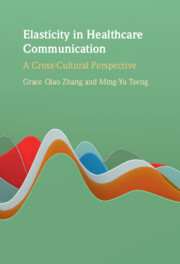Book contents
- Elasticity in Healthcare Communication
- Elasticity in Healthcare Communication
- Copyright page
- Contents
- Figures
- Tables
- Acknowledgements
- 1 Introduction
- 2 Theoretical Foundations
- 3 Methodology
- 4 Elastic Language Used in Chinese
- 5 Elastic Language Used in English
- 6 Comparison between Chinese and English Regarding Elastic Language Use
- 7 Perceptions of and Attitudes Towards the Use of Elastic Language in Chinese
- 8 Perceptions of and Attitudes towards the Use of Elastic Language in English
- 9 Comparison between Chinese and English Regarding Participants’ Feedback
- 10 General Discussion
- 11 Conclusions and Implications
- Book part
- References
- Author Index
- Subject Index
6 - Comparison between Chinese and English Regarding Elastic Language Use
Published online by Cambridge University Press: 04 August 2022
- Elasticity in Healthcare Communication
- Elasticity in Healthcare Communication
- Copyright page
- Contents
- Figures
- Tables
- Acknowledgements
- 1 Introduction
- 2 Theoretical Foundations
- 3 Methodology
- 4 Elastic Language Used in Chinese
- 5 Elastic Language Used in English
- 6 Comparison between Chinese and English Regarding Elastic Language Use
- 7 Perceptions of and Attitudes Towards the Use of Elastic Language in Chinese
- 8 Perceptions of and Attitudes towards the Use of Elastic Language in English
- 9 Comparison between Chinese and English Regarding Participants’ Feedback
- 10 General Discussion
- 11 Conclusions and Implications
- Book part
- References
- Author Index
- Subject Index
Summary
Quite a few elastic terms on the Chinese top-10 list are similar to their English counterparts or near-counterparts: keneng (可能) and may; chang (常)/tongchang (通常) and usually/often; hen (很) and very; geng (更) and more; duo (多)/xuduo (許多) and many/most. These cover epistemic, scalar and approximate stretchers. While the most frequently used general stretcher in Chinese is deng, the most commonly used general stretcher in English is things. In terms of how the four categories of EL are distributed, the Chinese and the English data exhibit two different patterns, i.e., SC-AQ-GE-EP and EP-AQ-SC-GE respectively. A series of comparisons of the most-used stretchers of each of the four categories in the Chinese and the English corpora yield some interesting findings. There is a clear preferred epistemic stretcher in online health information in Chinese and in English respectively, i.e. keneng (可能) and may.
- Type
- Chapter
- Information
- Elasticity in Healthcare CommunicationA Cross-Cultural Perspective, pp. 109 - 124Publisher: Cambridge University PressPrint publication year: 2022

